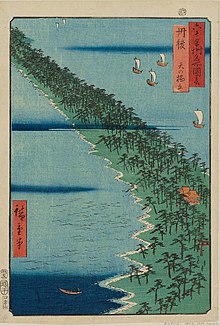Tango Province(Đan sau quốc,Tango-no kuni)was aprovince of Japanin the area of northernKyoto Prefecture.[1]Tango bordered onTanbato the south,Tajimato the west, andWakasato the east. Its abbreviated form name wasTanshū(Đan châu).It was also referred to asHokutan(Bắc đan)orOkutan(Áo đan).In terms of theGokishichidōsystem, Tango was one of the provinces of theSan'indōcircuit. Under theEngishikiclassification system, Tango was ranked as one of the "middle countries" ( Trung Quốc ) in terms of importance, and one of the "near countries" ( gần quốc ) in terms of distance from the capital. The provincial capital was located in what is now the city ofMiyazu.Theichinomiyaof the province is theKono Shrinealso located in Miyazu. The province had an area of 1,283.43 square kilometres (495.54 sq mi).


History
editEarly history
editThe Tango region prospered around the Takeno River basin (present-dayKyōtangocity) during theKofun period,during which time many keyhole-shapedburial moundswere constructed. As coins from theXin dynastyof northern China have been found in the from theHakoishihama Sitein Kumihama, Kyōtango, it is clear that the area had trade connections with the Asian continent. Also, in theNihon Shoki,when the Yamato Kingdom sent four generals in four directions to conquer the country, ancientTanbawas the only specific destination mentioned, highlighting its importance to the Yamato rulers as a transportation center towards Asia.
The province of Tango was created in 713 during the reign ofEmpress Genmeiby separating the northern five districts (Kasa District, Yoza District, Tamba District (later Naka District), Takeno District, and Kumano District) of northern Tanba Province.[2]InWadō 5(712),Mutsu Provincehad been severed fromDewa Province.[2]The "Wamyō Ruijushō"lists 35 townships in the area, and states that the area was ruled by the Tanba-no-atai clan, who were theKuni no miyatsuko.Per theKujiki,this clan claimed descent from thekamiAmenohoakari,who was either the younger brother or son ofNinigi-no-mikoto.Theprovincial capitalwas located in Kasa District, possibly in the Fuchū neighborhood ofMiyazu,but the precise location is uncertain. The site of theTango Kokubun-ji(also in Miyazu) is known, and is aNational Historic Site.TheEngishikirecords of 927 list seven major and 58 minorShinto shrines,withKono Jinjaas theichinomiyaof the province.[3]
During the earlyMuromachi period,theYamana clanwereshugoof Tango province, but they were supplanted by theIsshiki clanin 1392. The Isshiki ruled until replaced byHosokawa Fujitakain 1579, who constructedTanabe Castle,also known as “Maizuru Castle” under orders ofOda Nobunaga.
Edo Period
editIn 1600, the Hosokawa clan was transferred toKyushuand all of Tango Province was awarded toKyōgoku Takatomo,who establishedMiyazu Domainunder theTokugawa shogunate.In 1622, he divided his 123,000kokuholdings, with 35,000kokugoing to his third son, Kyōgoku Takamitsu,who established a cadet branch atTango-Tanabe Domainand 10,000kokuto a grandson,Kyōgoku Takamichi,who establishedMineyama Domain.This proved a wise decision, as in 1666 The Kyōgoku clan was dispossessed of Miyazu Domain for bad administration, and reduced tohatamotostatus. Miyazu Domain was reduced in size and passed to a number offudai daimyōclans until 1758 when it came under the control of the Honjō-Matsudaira clan. Tango-Tanabe Domain fared better in that it remained in Kyōgoku hands until 1668, when the clan was transferred toToyooka DomaininTajima Provinceand replaced by a cadet branch of theMakino clan.Mineyama Domain remained with the Kyōgoku until theMeiji restoration.Territory directly controlled by the shogunate was administered by Kumihamadaikanshō.During the Edo Period, Tango province was somewhat of a backwater, due to its geographical location. In the mid-Edo period, Mineyama Domain brought in craftsmen fromNishijinto introduce the technique of producing silkcrepecloth, which was namedTango chirimen.This became a regional speciality and a source of income for both Miyazu and Mineyama Domains.
| Name | Clan | Type | kokudaka |
|---|---|---|---|
| Miyazu | Honjō-Matsudaira clan | Fudai | 70,000koku |
| Tango-Tanabe | Makino clan | Fudai | 35,000koku |
| Mineyama | Kyōgoku clan | Tozama | 13,000koku |
Meiji period
editFollowing theMeiji restoration,each of the domains (Miyazu, Tango-Tanabe and Mineyama) briefly became prefectures, which were annexed to Toyooka Prefecture in November 1871 and incorporated into Kyoto Prefecture in 1876.[4]Per the earlyMeiji periodKyudaka kyuryo Torishirabe-chō(Cũ cao cũ lĩnh điều trướng),an official government assessment of the nation's resources, the province had 409 villages with a totalkokudakaof 146,724koku.Tango Province consisted of:
| District | kokudaka | Controlled by | at present | Currently |
|---|---|---|---|---|
| Kumano(Hùng dã quận) | 18,333koku | Tenryō(52 villages) | dissolved | part ofKyōtango |
| Naka(Trung quận) | 21,911koku | Tenryō(9 villages) Mineyama (1 town, 19 villages) Miyazu (5 villages) joint Mineyama/Miyazu (1 village) jointTenryō/Miyazu (1 village) |
dissolved | part of Kyōtango |
| Takeno(Trúc dã quận) | 25,223koku | Tenryō(47 villages) Miyazu (27 villages) joint Tenryo/Miyazu (1 village) |
dissolved | part of Kyōtango |
| Yosa(Cùng tạ quận) | 42,175koku | Tenryō(9 villages) Miyazu (3 towns, 82 villages) jointTenryō/Miyazu (1 village) |
Ine,Yosano,most ofMiyazu,part of Kyōtango andFukuchiyama | |
| Kasa(Thêm tá quận) | 39,079koku | Tenryō(3 villages) Tango-Tanabe (1 town, 134 villages) Miyazu (11 villages) jointTenryō/Tango-Tanabe (1 village) |
dissolved | Maizuru,part of Fukuchiyama, Miyazu |
Although the province no longer officially existed after 1871, the name continued to be used for some purposes. For example, Tango is explicitly recognized in treaties in 1894 between Japan and theUnited Statesand between Japan and theUnited Kingdom.[5]
Gallery
edit-
Kono Jinja,ichinomiyaof the province
-
Ruins of Tango Kokubun-ji
-
Tanabe Castle, also known as Maizuru Castle
-
Ama-no-Hashidate
Notes
edit- ^Nussbaum, Louis-Frédéric.(2005). "Izu"inJapan Encyclopedia,p. 411,p. 411, atGoogle Books.
- ^abTitsingh, Isaac. (1834).Annales des empereurs du japon,p. 64.,p. 64, atGoogle Books
- ^"Nationwide List ofIchinomiya",p. 2.;retrieved 2011-08-10
- ^Nussbaum,"Provinces and prefectures"at p. 780.
- ^US Department of State. (1906).A digest of international law as embodied in diplomatic discussions, treaties and other international agreements(John Bassett Moore, ed.), Vol. 5, p. 759.
References
edit- Nussbaum, Louis-Frédéricand Käthe Roth. (2005).Japan encyclopedia.Cambridge:Harvard University Press.ISBN978-0-674-01753-5;OCLC58053128
- Papinot, Edmond. (1910).Historical and Geographic Dictionary of Japan.Tokyo: Librarie Sansaisha.OCLC 77691250
- (in Japanese)Kōzuke on "Edo 300 HTML"
External links
editMedia related toTango Provinceat Wikimedia Commons